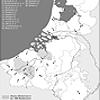De sacra militia contra iconomachos: Civic Strategies to Counter Iconoclasm in the Low Countries (1566)
DOI:
https://doi.org/10.18352/bmgn-lchr.10177Keywords:
Iconoclastic Fury, Iconoclasm, History, Low Countries, BelgiumAbstract
Although the iconoclastic scare must have been enormous and the actual impact of the attacks of summer and autumn 1566 can hardly be exaggerated, the Beeldenstorm was not as comprehensive as it seemed to contemporaries and subsequent historians. Indeed, a considerable number of important cities in the Habsburg Netherlands actually managed to ward off destruction, but until now their role has hardly been studied.
The aim of this article is twofold: first, it seeks to chart the cities in question. Second, it analyses the preventive measures that they took against the violence. In so doing, it nuances the idea of theBeeldenstormas an all-destructive wave, and provides insights into the dynamics of the Iconoclastic Fury. More specifically, the cliché that the passivity of magistrates was the main reason for all losses seems in need of considerable revision.
This article is part of the special issue 'Beeldenstorm'.
De sacra militia contra iconomachos. Stedelijke maatregelen tegen de Beeldenstorm in de Lage Landen (1566)
Ondanks de reële iconoclastische dreiging en de enorme impact van de vernielingen in de zomer en herfst van 1566, was de Beeldenstorm niet zo grondig en alomvattend als ze door tijdgenoten en latere historici werd beschreven. Een aanzienlijk aantal belangrijke steden in verschillende gewesten van de Habsburgse Nederlanden wist inderdaad aan de vernielingen te ontsnappen, maar hun rol werd tot nu toe nauwelijks bestudeerd.
Het doel van dit artikel is daarom tweeledig: enerzijds worden de steden in kwestie in kaart gebracht, anderzijds wordt onderzocht welke maatregelen zij namen ter preventie van het geweld. Naast het feit dat dit het idee van de Beeldenstorm als allesverwoestend sterk kan nuanceren, leidt het tot een aantal interessante inzichten in de precieze aard van de storm. Vooral het cliché van de niet-ingrijpende magistraat als belangrijkste reden voor de massale verliezen blijkt aanzienlijk herzien te moeten worden.
Dit artikel maakt deel uit van het themanummer 'Beeldenstorm'.
Downloads

Published
Issue
Section
License
Authors who publish with this journal agree to the following terms:
a) Authors retain copyright and grant the journal right of first publication with the work simultaneously licensed under a Creative Commons Attribution 4.0 International (CC BY 4.0) that allows others to share the work with an acknowledgement of the work's authorship and initial publication in this journal.
b) Authors are able to enter into separate, additional contractual arrangements for the non-exclusive distribution of the journal's published version of the work (e.g., post it to an institutional repository or publish it in a book), with an acknowledgement of its initial publication in this journal.
c) Authors are permitted to post their work online (e.g., in institutional repositories or on their website) prior to and during the submission process.
Authors are explicitly encouraged to deposit their published article in their institutional repository.











